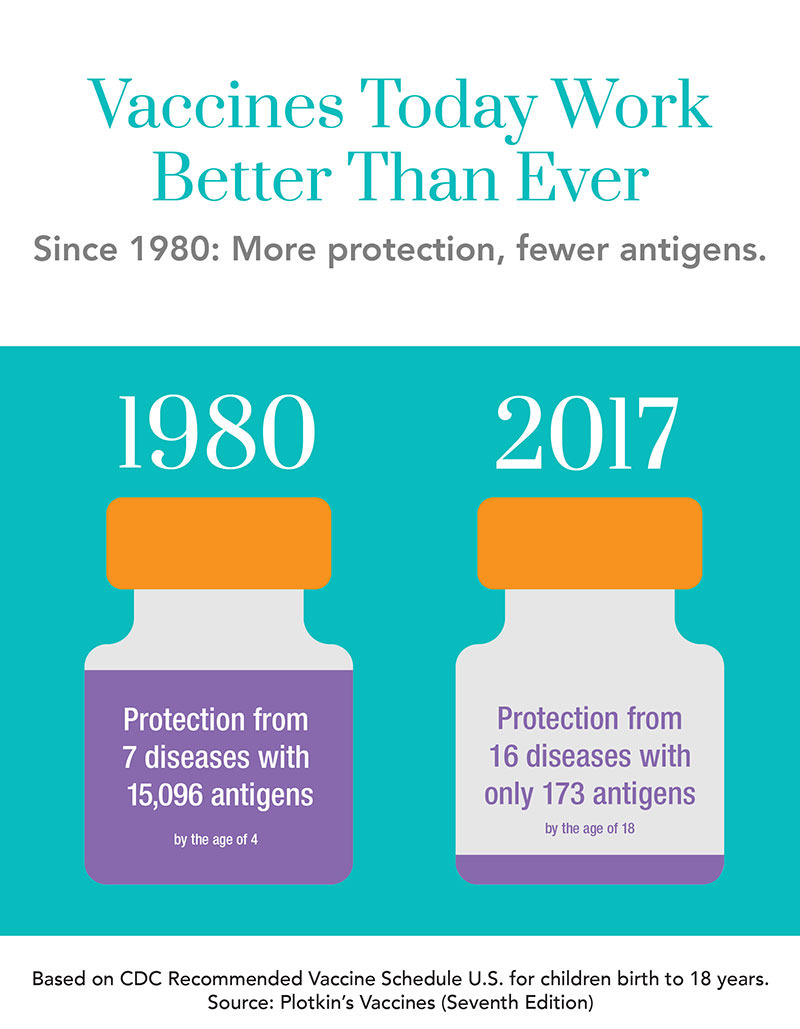Combination vaccines take two or more vaccines that could be given individually and put them into one shot. Children get the same protection as they do from individual vaccines given separately—but with fewer shots.
At a doctor’s visit, your child may only get two or three shots to protect him or her from five diseases, instead of five individual shots. Fewer shots may mean less pain for your child and less stress for you.
Combination vaccines help parents, doctors, and nurses keep children up to date on vaccines. Combining vaccines into fewer shots may also mean that more children will get recommended vaccinations on time. And that means fewer delays in disease protection for children.
Combination vaccines do not overload your child’s immune system. Vaccines contain ingredients called antigens, which tell the body’s immune system to create those antibodies. Every day, a healthy child’s immune system successfully fights off thousands of antigens—the parts of germs that cause the body’s immune system to go to work.
The antigens in vaccines come from the germs themselves, but the germs are weakened or killed so they cannot cause serious illness. Vaccines contain only a tiny fraction of the antigens that children encounter every day in their environment, even if they receive several vaccines on one day.
- Kids are exposed to 2,000 to 6,000 antigens every day.
- A strep throat infection, for example, exposes children to at least 25 to 50 antigens. That’s comparable to the antigens in the vaccines that infants get at their two-month visit–the DTaP, IPV, HepB, Hib, and rotavirus vaccines combine to just 54 antigens.
And even though children receive more vaccines to protect against more diseases now compared to 30 years ago, the actual number of antigens in vaccines is dramatically less than decades ago because vaccine technology has improved, making vaccines more efficient.
- In 1980, the recommended vaccines contained more than 15,096 antigens.
- Today’s vaccines contain only 173 antigens in 12 vaccines that protect children and teens against 16 vaccine-preventable diseases.

Source: Plotkin’s VACCINES, 7th Edition
Some examples of common combination vaccines for children are:
- Comvax, which combines the vaccines that prevent Haemophilus influenzae type b and Hepatitis B
- Twinrix, which combines the vaccines that prevent Hepatitis A and Hepatitis B
- Pediarix, which combines the vaccines that prevent tetanus, diphtheria and pertussis (whooping cough), Hepatitis B, and polio
- ProQuad, which combines the vaccines that prevent measles, mumps and rubella and varicella (chickenpox)
- Kinrix, which combines the vaccines that prevent tetanus, diphtheria and pertussis (whooping cough) and polio
- Pentacel, which combines the vaccines that prevent tetanus, diphtheria and pertussis (whooping cough), polio and Haemophilus influenzae type b
Before a combination vaccine is approved for use, it goes through careful testing to make sure the combination vaccine is as safe and effective as each of the individual vaccines given separately. And, just as with individual vaccines, there are systems in place to watch for any rare reactions to combination vaccines that can be detected only after the vaccine is used widely.
Learn more about each vaccine and what they protect against.
Sources:
CDC: Combination Vaccines
Verywell: Antigen Counts in Vaccines
